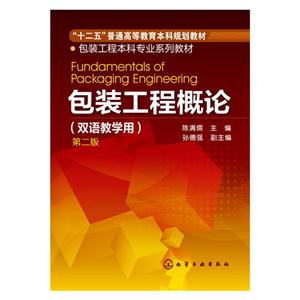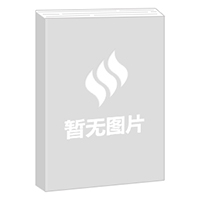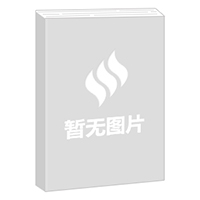包裝工程概論-第二版-(雙語教學(xué)用) 版權(quán)信息
- ISBN:9787122206800
- 條形碼:9787122206800 ; 978-7-122-20680-0
- 裝幀:暫無
- 冊數(shù):暫無
- 重量:暫無
- 所屬分類:>>
包裝工程概論-第二版-(雙語教學(xué)用) 本書特色
該教材主要包括:unit 1an overview of packaging 包裝概述、unit 2 packaging materials and containers 包裝材料和容器、unit 3 packaging dynamics and distribution packaging 包裝動力學(xué)與運(yùn)輸包裝、unit 4 packaging technology 包裝技術(shù)、unit 5 packaging development 包裝研發(fā)。
包裝工程概論-第二版-(雙語教學(xué)用) 內(nèi)容簡介
本書是在**版同名教材的基礎(chǔ)上修訂而成的。全書由包裝概述、包裝材料和容器、包裝動力學(xué)與運(yùn)輸包裝、包裝工藝與設(shè)備和包裝研發(fā)共5個單元20課組成。修訂后的教材內(nèi)容補(bǔ)充了國外包裝工程學(xué)科專業(yè)的*新資料,使之更能體現(xiàn)包裝工程的專業(yè)特色。同時,為體現(xiàn)雙語教學(xué)的內(nèi)涵和特點(diǎn),方便組織教學(xué)和自主學(xué)習(xí),教材修訂中也注重了內(nèi)容的易于閱讀和理解性。一是在每篇課文之后列出了專業(yè)詞匯、疑難句注釋和復(fù)習(xí)題;二是全部課文原文配有中文翻譯和教學(xué)用演示文稿ppt;三是在全書*后附了詞匯總表及索引。本教材既適合包裝工程本科專業(yè)開展雙語教學(xué),也可作為從事包裝及相關(guān)專業(yè)的技術(shù)人員提高業(yè)務(wù)及其專業(yè)英語應(yīng)用水平的學(xué)習(xí)參考書。
包裝工程概論-第二版-(雙語教學(xué)用) 目錄
unit 1an overview of packaging1lesson 1a historical perspective on packaging11what is packaging?12primitive packaging23from rome to the renaissance34the industrial revolution55the evolution of new packaging roles66packaging in the 20th century87modern packaging97.1changing needs and new roles97.2packaging and the modern industrial society97.3world packaging118waste management and environmental issues129the modern packaging industry16lesson 2basic functions of packaging221introduction222the containment function233the protection/preservation function234food preservation244.1the nature of food244.2meat products264.3fish264.4produce264.5barrier packaging274.6microorganisms285the transport function356the information/sales function36unit 2packaging materials and containers42lesson 3paper and paperboard421introduction422representative papermaking machines422.1fourdrinier machines422.2cylinder machines432.3twinwire machines453machine direction and cross direction454surface or dryend,treatments and coatings465paper chracterization475.1caliper and weight475.2brightness485.3paper and moisture content485.4viscoelasticity496paper types496.1newsprint and related grades496.2book papers496.3commercial papers496.4greaseproof papers506.5natural kraft paper506.6bleached krafts and sulfites506.7tissue paper506.8label paper506.9pouch papers516.10containerboards(linerboard and medium)517paperboard grades517.1chipboard,cardboard,newsboard517.2bending chipboard517.3lined chipboard517.4single whitelined(swl)paperboard527.5claycoated newsback(ccnb)527.6double whitelined(dwl)paperboard527.7solid bleached sulfate(sbs)527.8food board527.9solid unbleached sulfate(sus)52lesson 4corrugated fiberboard boxes571historical perspective572corrugated board582.1construction582.2flutes592.3fiberboard grades602.4corrugating adhesives612.5board manufacture623fiberboard characterization tests633.1mullen burst test(tappi t 810)633.2edgewise compression test(tappi t 811)633.3flat crush test(tappi t 808).643.4combined weight of facings643.5thickness of corrugated board(tappi t 411)643.6gurley porosity(tappi t 460 and t 536)643.7flexural stiffness(tappi t 820)643.8water takeup tests(tappi t 441)643.9puncture test(tappi t 803)643.10pin adhesion(tappi t 821)653.11ply separation(tappi t 812)653.12coefficient of friction(tappi t 815 and astm 04521)654corrugated boxes654.1selecting the correct flute654.2box styles674.3manufacturers joint684.4dimensioning685carrier rules685.1application685.2summary of rules for corrugated box construction69lesson 5metal containers751background752common metal container shapes763threepiece steel cans774twopiece cans794.1draw processes794.2drawandredraw process794.3drawandiron process805impact extrusion816aerosols836.1aerosol propellants836.2other pressurized dispensers84lesson 6glass containers891glass types and general properties892bottle manufacture902.1blowing the bottle or jar902.2annealing922.3surface coatings922.4inspection and packing933bottle design features933.1bottle parts and shapes933.2finish and closures943.3neck and shoulder areas943.4sides943.5heel and base953.6stability and machinability953.7vials and ampoules953.8carbonated beverages96lesson 7plastics in packaging981introduction to plastics982thermoplastic and thermoset polymers1003shaping plastics1014plasticating extruders1015extrusion1025.1profile extrusion1025.2sheet and film extrusion1035.3blownfilm extrusion1035.4orientation1045.5coextrusion1056injection molding1056.1injection molding machines1056.2coinjection molding1067extrsion blow molding1068injection blow molding1079thermoforming1099.1principle and applications1099.2thermoforming methods1099.3billow forming11010other forming methods11110.1pressblowing11110.2rotational molding11110.3compression molding11110.4blowfillseal molding11211recognizing molding methods112lesson 8flexible packaging laminates1161laminates1162aluminum foil 1162.1chemical characteristics1172.2aluminum foil in flexible packaging1172.3foil coatings1183vacuum metallizing1193.1the metallizing process1193.2vacuummetallizing paper1203.3vacuummetallizing films1204other inorganic coating1214.1silicone oxides1214.2carbon coatings1214.3nanocomposites1215laminate structural and physical properties1215.1coefficient of friction1225.2body and deadfold properties1235.3tear properties1235.4 thermoformability1235.5use environments1236flaxible bags,pouches and sachets1237sealability1268barrier properties1279laminating processes1299.1bonding methods1299.2laminating machines1299.3coating stations13010specifying laminates132lesson 9closures1381selection considerations1382tamper evident closures1393tamper evident systems1404childresistant closures142unit 3packaging dynamics and distribution packaging145lesson 10shock,vibration,and compression1451shock1451.1shock resulting from drops1451.2shock during rail transport1471.3other shock conditions1471.4quantifying shock fragility1481.5cushioning against shock1512vibration1522.1vibration damage due to relative motion1532.2vibration resonance1532.3stack resonance1542.4isolating vibration1553compression1563.1static and dynamic compression1563.2compression strength and warehouse stack duration1573.3compression strength and humidity1573.4other factors influencing box stack strength1573.5contents’ effect on compression strength1593.6plastic bottle stacking factors1613.7stacking and compression1613.8distribution environment and container performance1623.9estimating required compression strength163lesson 11mechanical shock1691introduction1692the freely falling package1693mechanial shock theory1714shock duration1765shock amplification and the critical element1776horizontal impacts179lesson 12lansmont six step method1841step 1 define the environment1851.1shock environment1851.2vibration environment1872step 2 product fragility analysis1882.1shock:damage boundary1882.2vibration:resonance search &dwell1913step 3 product improvement feedback1924step 4 cushion material performance evaluation1924.1shock cushion performance1924.2vibration cushion performance1935step 5 package design1945.1shock:package design1945.2vibration:package design1955.3package design considerations1966step 6 test the product/package system1966.1shock:package testing1966.2vibration:package testing197lesson 13distribution packaging2001short history of distribution packaging in the usa2002functions and goals of distribution packaging2002.1containment2002.2protection2002.3performance2002.4communication2012.5product protection2012.6ease of handling and storage2012.7shipping effectiveness2012.8manufacturing efficiency2012.9ease of identification2012.10customer needs2012.11environmental responsibility2013the cost of packaging2014the package design process2025taking a total system approach to package design2026the protective package concept2037the 10step process of distribution packaging design2057.1identify the physical characteristics of the product2057.2determine marketing and distribution requirements2057.3learn about the environmental hazards your packageswill encounter2057.4consider packaging and unitizing alternatives2057.5design the distribution package2057.6determine quality of protection through performancetesting2067.7redesign package(and unit load)until it successfullypasses all tests2067.8redesign the product if indicated and feasible2067.9develop the packaging methods2077.10document all work2078a final check2079the warehouse20710unit loads20810.1pallets20810.2unit load efficiency21010.3stabilizing unit loads211lesson 14test method for product fragility2151shock:damage boundary2151.1conducting a fragility test2172vibration:resonance search & dwell219lesson 15stressenergy method for determining cushion curves2231current practice2232something new2233stressenergy method2244procedure to find the stressenergy equation2255using the stressenergy equation to generate cushion curves2266test procedure2267conclusion228unit 4packaging technology and machinery230lesson 16liquid filling2301introduction2302type of filling machine2303use of filling machines2314rotary and straightline fillers2315liquid volumetric filling2315.1introduction2315.2piston volumetric filling2325.3diaphragm volumetric filling2355.4timed flow volumetric filling2365.5rotating metering discs2365.6rotary pumps2375.7augers2386liquid constant level filling2386.1introduction2386.2pure gravity filling2386.3pure vacuum filling2406.4gravity vacuum filling2416.5pure pressure filling2426.6level sensing filling2426.7pressure gravity filling243lesson 17dry product filling2481introduction2482type of dry products2483type of dry filling operations2484product delivery2495dry volumetric filling2495.1introduction2495.2cup or flask fillers2495.3flooding or constant stream fillers2515.4auger fillers2515.5vacuum fillers2526dry filling by weight2536.1introduction2536.2net weight filling2536.3gross weight filling2546.4types of scales2557filling by count2567.1introduction2567.2board or disc counters2567.3slat counters2577.4column counters2587.5electronic counters2597.6maintenance259lesson 18applied packaging(i)2621carded display packages2622blister packages263lesson 19applied packaging(ii)2661carded skin packaging2662pharmaceutical packaging2672.1drug properties2672.2packaging emphases2682.3regulations2692.4manufacturing practice270unit 5packaging development273lesson 20packaging development process2731managing the packaging project2732project scope2743the package development process2753.1an overview of the package development process2753.2generating ideas2763.3the package design brief2773.4the development timetable2803.5development and testing of alternatives2804specifications281glossary 285resources316
展開全部
包裝工程概論-第二版-(雙語教學(xué)用) 作者簡介
陳滿儒, 陜西科技大學(xué),教授 總支書記, 陜西科技大學(xué)包裝工程專業(yè)三級教授,包裝工程省級重點(diǎn)建設(shè)學(xué)科帶頭人。1978年2月-1981年12月在中南大學(xué)鐵道機(jī)械工程專業(yè)學(xué)習(xí),取得工學(xué)學(xué)士學(xué)位;1982年2月-1984年12月在陜西科技大學(xué)機(jī)械工程專業(yè)學(xué)習(xí),取得工學(xué)碩士學(xué)位;1996-1998年獲中英獎學(xué)金赴英國Liverpool University機(jī)械工程專業(yè)研修;2003-2004年獲得國家留學(xué)基金管理委員會資助赴美國Wisconsin-Stout大學(xué)包裝專業(yè)作訪問學(xué)者。2004-2005年任國際交流與合作辦公室副主任;2005年6月-2010年7月任外國語與傳播學(xué)院院長;2010年7月至今任設(shè)計(jì)與藝術(shù)學(xué)院黨總支書記。 作為課程負(fù)責(zé)人主講的《包裝技術(shù)》獲陜西省雙語教學(xué)示范課程(2008年)和國家雙語教學(xué)示范課程(2010年);作為負(fù)責(zé)人的“包裝工程”本科專業(yè)獲得國家特色專業(yè)(2010年);作為帶頭人的“‘包裝工程'專業(yè)教學(xué)團(tuán)隊(duì)”獲得陜西省普通高等學(xué)校教學(xué)團(tuán)隊(duì)(2007年);主持完成的 “《包裝工程概論(雙語)》教材及網(wǎng)絡(luò)課件”獲得陜西省教學(xué)成果二等獎(2007年);目前在研的省級教改項(xiàng)目為“面向國際化專業(yè)人才培養(yǎng)的雙語教學(xué)改革的研究與實(shí)踐”。 作為作者共發(fā)表學(xué)術(shù)論文50多篇。其中核心論文40篇,檢索論文有“ Estimate of Discrete Non-liearities in a Mainly Linear Dynamic System ” 《機(jī)械工程學(xué)報(bào)(英文版)》,“A Test Software for Cushioning Characteristics of Packaging Materials”《Applied Mechanics and Materials》等5篇。主持或參與完成了省級科研項(xiàng)目“包裝與包裝機(jī)械科技服務(wù)平臺”等8項(xiàng)科研課題。曾榮獲“陜西省師德標(biāo)兵”(2006年)和“陜西省教學(xué)名師”(2007年)稱號。現(xiàn)擔(dān)任教育部印刷包裝教學(xué)指導(dǎo)委員會委員、中國包裝聯(lián)合會包裝教育委員會副主任委員和包裝動力學(xué)分會理事等學(xué)術(shù)兼職。
















